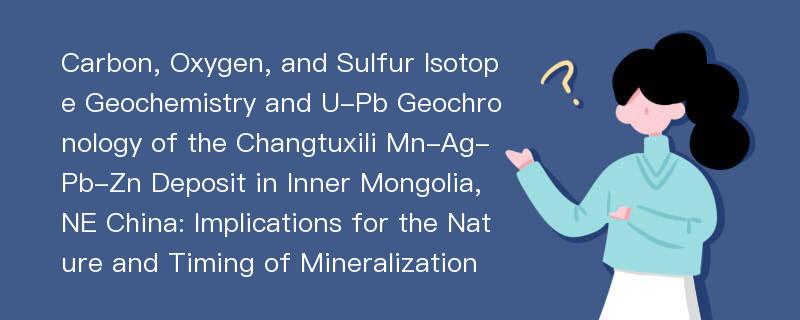
论文摘要
This study reports geochronological and isotopic(C, O, and S) data for the recently discovered Changtuxili Mn-Ag-Pb-Zn deposit by Tianjin Center on the western slopes of the southern Great Hinggan Range in NE China, to investigate the timing of mineralization and ore genesis. The mineralization is hosted by intermediate-acidic lavas and pyroclastic rocks of the Baiyingaolao Formation. Three stages of mineralization are identified: quartz-pyrite(Stage Ⅰ), galena-sphalerite-tetrahedriterhodochrosite(Stage Ⅱ), and quartz-pyrite(Stage Ⅲ). The δ13C and δ18O values for carbonate from the ore vary from –8.51 ‰ to –4.96 ‰ and 3.97 ‰ to 15.90 ‰, respectively, which are indicative of a low-temperature alteration environment. The δ34SCDT values of sulfides range from –1.77 ‰ to 4.16 ‰ and show a trend of equilibrium fractionation(δ34SPy > δ34SSp > δ34SGn). These features indicate that pyrite, galena, and sphalerite precipitated during the period of mineralization(Hoefs et al., 1987). The alteration mineral assemblage and isotope data indicate that the ore-forming fluid was derived largely from meteoric water and that the weakly acidic to weakly alkaline fluid and ore-forming elements C and S originated from magma(Hedenquist and Lowenstern, 1994). During the mineralization, a geochemical barrier was formed by changes in the pH of the oreforming fluid leading to the precipitation of rhodochrosite. Based on the characteristics of the mineralization, new isotope data, and comparison with adjacent deposits, we propose that the Changtuxili Mn-Ag-Pb-Zn deposit is an intermediate-to lowsulfidation epithermal deposit that was controlled by fractures and varieties in the pH of the ore-forming fluid(Jin et al., 2017; Zeng et al., 2011). The surrounding volcanic rocks yield U-Pb zircon ages of 146-160 Ma(Late Jurassic), indicating that the mineralization is younger than 146 Ma.
论文目录
文章来源
类型: 国际会议
作者: ZHANG Kuo,JIN Ruoshi,SUN Fengyue,LI Bile,HE Peng,GUO Shuo,ZHANG Tianfu
来源: 第九届世界华人地质科学研讨会 2019-06-01
年度: 2019
分类: 基础科学,工程科技Ⅰ辑
专业: 地质学,矿业工程
单位: Tianjin Center,China Geological SurveyNorth China Center for Geoscience InnovationCollege of Earth Sciences, Jilin University
分类号: P618.4
DOI: 10.26914/c.cnkihy.2019.028358
页码: 144
总页数: 1
文件大小: 203k
下载量: 1
